Australia's entire fiscal year begins on July 1 of each year and runs from June 30 of the following year. And every year after June 30, people need to enter the intense work of various tax returns. If you do not return taxes in time, you will be in Australia, do a lot of things will be stuck, but also will receive a fine of $210 and $8,500!
If you don't file a tax and you don't pay a fine, then hehe ~ look at the following possible events:
Fine is interest, do not pay is accumulated all the time;
Notice of claim will be received at the beginning.
If you don't deal with it, then you can wait for a subpoena.
You have the personality, still ignore? OKOK~, then wait to be prosecuted, and then continue to be fined and jailed!
If you dare to violate any of the provisions of the tax law, especially foreign immigrants, for example, do not declare an overseas account. This one violation alone can be fined more than 10,000 Australian dollars! A minute's penalty for losing his fortune.
If you want to say, I have no income! I'm a student! That doesn't matter, you have to hand in the papers!
Under Australian law:
1. Any Australian tax resident, whether his income comes from within or outside Australia, is required to file his income tax with the Australian Inland Revenue Authority (ATO)!
2. As long as you stay in Australia for more than 183 days, you may be recognized as an Australian tax resident and subject to tax obligations! Individuals who do not have permanent residency or citizenship do not represent exemption from tax obligations as a result, and international students are tax residents!
3. Even non-earners or babies earning less than $18200 a year will have to submit a "Non-Lodgement Advice" to the Inland Revenue Department after June 30 each year.
The deadline for self-filing of taxes is October 31 of each year and may be extended to March 31 of the following year in the case of entrusted accountants.
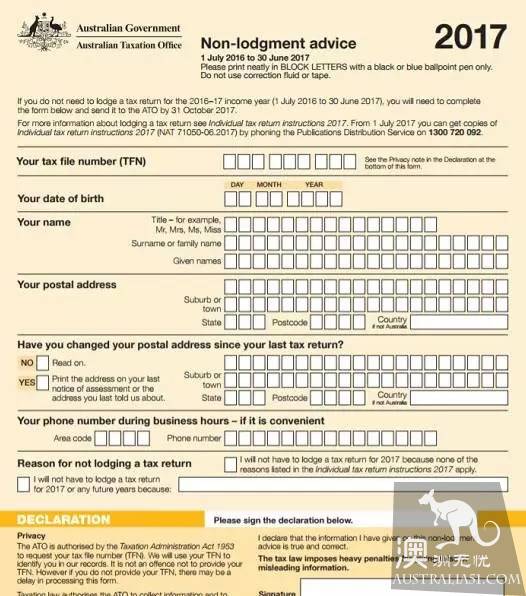
(chart above shows no income statement)
TIPS:
When applying for a tax number, many foreign student friends have an option to ask you if you are "Resident on Tax Purpose" and do not mistakenly think that you are an Australian resident or an PR, but whether you are an Australian tax resident. If this condition is met, you should choose yes!
What are the consequences of late filing or non-filing?
From July 1, 2017, if you delay 28 days, you may be fined $210, if you continue not to report, you may be fined up to $1050!
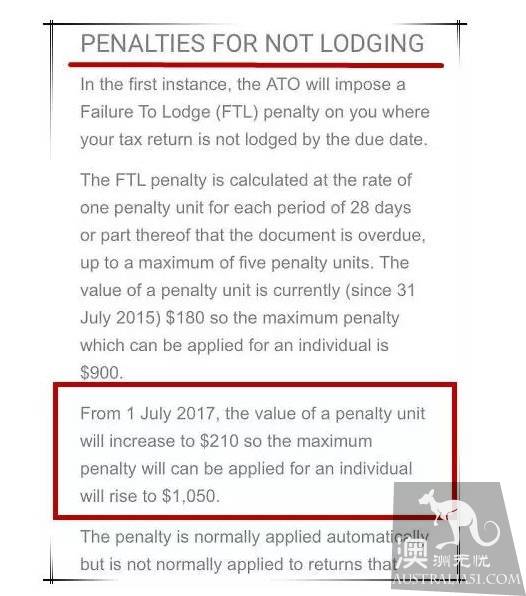
If you didn't mean to, you can appeal to the ATO for a fine waiver, and ATO will decide how much you will end up paying, depending on your circumstances, provided, of course, that your reasons are justified. In rare cases, if you act too badly, ATO may consider prosecuting you, and when this happens, you may be fined $8500 or 12 months in prison.

So, please assess whether you are an Australian tax resident, comply with local laws and regulations, file taxes on time, and be a good citizen.
In recent years, the Australian government has found that tax evasion and "reasonable tax avoidance" of more and more Chinese, so the response is one by one.
Chinese small businesses, for example, are targeted at small business owners such as cafes, restaurants, hair salons, takeout businesses, beauty salons, express delivery companies and blue-collar technicians.
In the latest ATO campaign in 2017, they hired Asian Language investigators to conduct a comprehensive survey of large and medium-sized cities such as Sydney, Melbourne, Gold Coast and Adelaide.
But the door-to-door investigation isn't enough, and there's a lot more to it:
Using personal information to check tax evasion, monitor moments, in addition to banks, employers, insurance companies, government agencies and so on must provide taxpayer information, ATO will also investigate car registration records, stocks, online sales platform transactions records. And kids' tuition fees, immigration records and immigration data! Not to mention, even moments, or any social media content, will be "evidence" of the investigation!
There were three children of an Australian couple studying in private schools, which together cost more than A $70, 000 a year. In addition, the family of five used to travel abroad on a business-class plane, as well as photos of po on Facebook taking a holiday at the Whistler ski resort in Canada!
All this is listed by ATO as income evidence that they lied about their actual income! The end result is, penalty! Penalty to death! And! In this fiscal year tax returns, ATO (Australia Tax Office) also listed the "unreasonable tax avoidance" table! Specifically crack down on unreasonable tax avoidance!
Seven key points of ATO in 2017: "pay close attention" to the Direction of tax rebate
Fare (A $8 billion per annum):
ATO says that if you can't prove that you work at home and you have to go to several places at the same time to complete a job, you won't want to refund the tax! In addition, your car must also carry large vehicles or equipment to prove that you really need to drive the car to complete the work.
Freight charges for large cargo:
If you want to refund this part of the tax, you have to prove that your employer requires you to load the tools or equipment, and it must be because of the need for your job.
Accommodation (A $2 billion per annum):
If you have to eat and sleep outside because of your job is tax rebate, but if your employer has given you this part of the money, this money also as income declaration!
Internet and cell phone charges:
Tax rebate up to A $50 per person, no receipt. But! You still have to prove that all these expenses are spent on the job.
Work clothes:
Clothing cleaning fees, work protectors and uniform mandatory clothing costs are refundable. But shirts, suits, these things, even if the employer forces you to wear them, you can't ask for a refund.
Continuing education ($2 billion per annum):
The declared course must be directly related to the existing job, otherwise there will be no way!
Home office costs ($7 billion per annum):
You must prove that these means of production, equipment (or other) are used directly to make money. In addition, paper, ah, computer bags, office supplies, these expenses, ah, you can also return the money back. However, if you are not self-employed, but are asked by your employer to work from home, then you can only refund a certain percentage of office supplies money.
The above mentioned a lot of methods to return taxes, but you know, in Australia, personal income tax can also be refunded?!
New arrivals to Australia need to know a lot of things, and tax rebate is a matter of particular interest. Therefore, whether it is socialism or capitalism, up to the president / prime minister, down to ordinary people, paying taxes is an important duty and duty for everyone.
In short, the Government accepts a general principle:
High income pay more tax, low income first pay tax rebate!
What exactly is "personal income tax Personal Income Tax"?
Personal income tax (Personal Income Tax) is a general term that regulates the social relations between taxation authorities and natural persons (residents, non-residents) in the process of collection and management of personal income tax.
Salary, salary income, refers to salary, bonus, year-end raise, labor bonus, allowance, allowance and other income related to employment or employment of an individual as a result of his or her employment or employment.
In other words, as long as the income obtained by an individual is related to employment or employment, regardless of the channel of fund expenditure of his unit or the payment in the form of cash, in kind, securities, etc., it is the object of taxation of income items of wages and salaries.
Australian government tax requirements for individual income tax in Australia, individual income tax payers, both resident tax payer Residents, and non-resident tax payer Nonresidents.
Resident tax payer: having the obligation to pay taxes completely, he must pay personal income tax on all income derived from Australia and abroad;
Non-resident tax payer: individual income tax is paid only for income derived from Australia.
BUT! Because Australian bank interest is also involved in taxation, whether you are prepared to work in Australia or not, All must apply for their own Australian tax number, Tax File Number (TFN)-a personal tax number assigned to everyone by the Australian Revenue Service Australian Taxation Office (ATO) for tax purposes.
As for the application of the tax number, we can apply on the ATO website on our own. It is often easy for us to apply for the tax number. Here, the editor will not repeat it.
In addition, Australian residents pay a 2% annual health insurance tax (Medicare levy,), which is not required for non-Australian residents.
TIPS:
We must remember that when the tax number is applied, it will be mailed to the residential address and it must be collected. Because this is the only one, there is no spare tire!
When you get the tax number, you must submit it to the bank at the first time. Otherwise, when the bank issues interest on the 1st of each month, you will be surprised to find that the interest is received at the same time that some of it is withheld. That's tax!
Top priority! No matter how much tax you have made in this fiscal year, even $1 will have to be filed in the fiscal year!
Because Australia's laws are sound and strict, individuals will receive a fine notice if they fail to file tax returns to the Government within the prescribed time frame! The amount of the fine will vary according to the circumstances. If it is short, it will be hundreds or thousands of dollars, which is as large as tens of thousands of dollars!.
So, don't do anything to save tax. It's very likely that the dozens of dollars that could have been refunded would have gone up to a huge fine in an instant, and that would be more than worth the loss.
After all, when can I start to apply for personal tax rebate? Anytime? Absolutely Nott!
Living in Australia, as long as you have a tax number, you need to return tax and tax rebate!
Because Turkey and Australia are different from the Chinese, the fiscal year is June 30, not December 31, the end of the year.
Therefore, generally speaking, from July 1 of the previous year to June 30 of the current year, individuals' tax receipts and payments should be reported to the Inland Revenue Department (ATO,) after July 1, this year, that is, tax returns.
If you meet certain conditions, ATO will deduct a part directly from the tax you should have paid, which is the legendary tax deduction Rebate; If you actually pay more tax in a year than the tax payable, then you can get the return of ATO, that is, this article focuses on the study of the tax rebate
Since July 1, 2017, you will be ready to submit your tax returns for fiscal year 2016 / 17, and October 31, 2017 will be the deadline for filing your own tax returns.
If you choose to entrust an accountant to file a tax return instead of reporting it through the MyTax, the filing date can be extended to March 31 of the following year.
So, if you need a tax rebate, you should hurry up your time.
Let's play with the Australian personal tax rebate Guide!
In Australia, tax rebate preparation should be done fully!
Personal tax rebate, difficult to say, easy to say! "difficulty" lies in the multi-step and complexity of the process of filling out forms online, while "easy" lies in the simplicity of preparing the material and the fact that it will be very Easy~ as soon as it gets started.
Below, the editor will take stock of the preparation and required materials for the general public before the tax rebate.
Prior to the tax rebate, it is best for families to make sure they have the following documents or data in hand:
PAYG Payment Summary (Annual payroll Summary / tax statement): list of tax payments issued by the employer for each employee after the fiscal year. Once you get the list, you have to make sure your personal tax number and name are correct. If you've done two or more jobs in this fiscal year, make sure you've got all the employer's tax returns.
All bank interest income for a full fiscal year: since interest paid by banks in Australia is also closely related to taxes, from July 1, 16 to June 30, 1717, individual bank interest income, including current periods, Regular and Cash Management accounts need to be provided at the time of tax rebate.
Parents can ask the bank to issue a written certificate, or call the bank to inquire about the figures so that they can fill in the corresponding blanks in the form during the tax rebate process.
If there are students who are very good at fund management Netbanking, you can also query their own one-year interest income on the Internet, chicken stir-fried convenient!
Tax rebate for the previous fiscal year Notice of Assessment: if your friends have refunded personal income tax in the previous fiscal year, then this year's tax rebate needs the Notice of Assessment. sent to you by the ATO last year.
If you didn't know where to put these forms? Take your time! Just contact ATO and ask them to re-post another copy! So easy~~
Residents VS Non-Residents, what's the difference?
Under Australia's tax code, however, residents considered in Australia's tax code, whether their income is in Australia or abroad, are required to file their income tax with the ATO.
What are the residents recognized in the Australian tax Code? Generally speaking, if you are going to study or work for more than six months in Australia, you are considered to be a "Residents resident in Australia" and pay taxes and taxes at the same interest rate as Australian citizens; If you study or work in Australia for less than 6 months, you will be regarded as "a non-resident in Australia you Non-Residents", whose income during the year is taxable and cannot obtain the tax number TFN.
This comrade must provide an overseas address to the bank when he first opens an account in Australia, and the bank automatically deducts 10% of its bank interest income.
What is the way of tax rebate, self-help OR spent things?
In Australia, when fiscal year Financial Year approaches, personal tax rebates become one of the most important things that everyone knows and needs. And how on earth should this tax be refunded?
What tax rebate method best suits oneself? In fact, there are only two methods of personal tax rebate-
1, use your own MyTax software
2, fill in a form or find a professional accountant to do it.
If you own a company, own multiple real estate or investment income and high-income people, then it's the simplest and most appropriate way to get help from a professional! Because if such people DIY, themselves unless they are accounting or familiar, they can only catch them blind and collapse, because too many entries don't know how to do it.
However, if you do not want to spend money on professional tax rebate, it will be a good choice to use MyTax tax rebate. Look for the most powerful advantage of accounting tax rebate is-"reasonable tax avoidance"! Needless to say, we all know ~ but if friends like the editor are just ordinary people, nine to five low-and middle-income workers, and there is no too much complex investment and asset returns, then self-help tax rebate is undoubtedly a big choice! Also can save looking for accounting tax rebate Money oh, absolutely very good!
Do-it-yourself tax rebate, must be used is a ATO named MyTax on-line tax rebate program.
The following is a guide to the use of MyTax, strive to do novice rookie will learn, personal tax rebate easy to enter the account!
Hands teach you to play with MyTax, 's own DIY tax rebate is not a dream!
Last year, the full-scale implementation of MyTax only needs to audit 10 main pictures, compared with the previous E-TAX software will be easier to complete the tax returns, absolutely too much!
If you want to use MyTax for tax rebates, you first need to create an MyGov account and associate it with ATO so that you can use the account to check online for tax and pension Super, health insurance Medicare, benefits and other related matters.
Step one to create a MyGov account:
Click to enter the https://my.gov.au/, page and click the green Create a myGov account to start creating your own MyGov account.
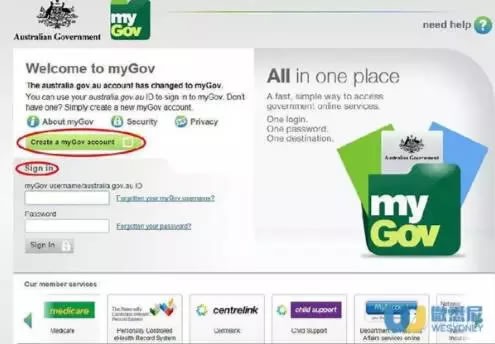
Once created, the page in the following figure appears, typing your e-mail address as required, and tick the box in front of I accept to indicate agreement to the terms and conditions, and then click Next to proceed to the next step.
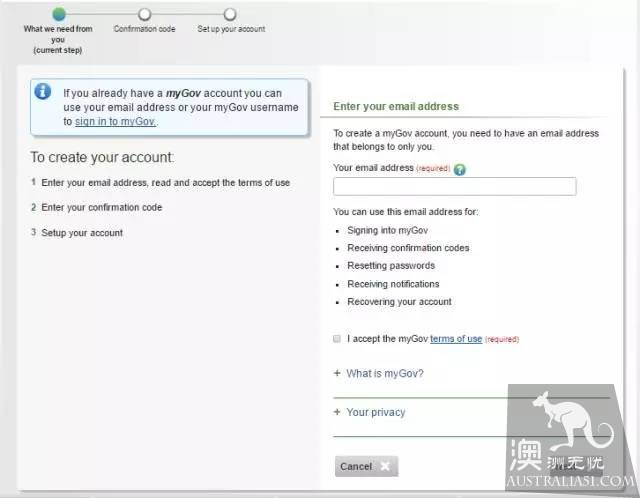
After entering the next step, the mailbox will receive a validation email from MyGov, enter the passcode in the message in the space on the way, and click Next to enter the final step of account creation.

The final step is to fill in personal information (cell phone number) and set the account password. The answers to the three questions set up by the password question desk must be remembered because they will be asked to answer these questions on the first login account. Fill in and click Next to complete the account creation ~

Step 2: connect the MyGov account to the ATO
After the account is created, you also need to connect the individual MyGov to the ATO, so that the tax rebate process can proceed smoothly.
After entering the personal account, click the Member Services entry, find the Australia Taxation Office, from the following list of choices and click the far right Link button to complete the connection between the MyGov account and the ATO. (there are other relatives of accounts that need Link to complete the connection on this page, too.)

When the connection is complete, you can see your connected service information at the bottom of the personal account home page. And, on this page, you can start a "tax rebate trip" where Lodge Tax Return, manages its tax and pension information (after Link's own Super account) and checks and modifies its own personal information.

The third step is ready to start the "personal tax rebate trip".
After entering ATO linked service, click the first Lodge your return using myTax, in the Quicklinks category to quickly enter myTax's personal tax rebate program.
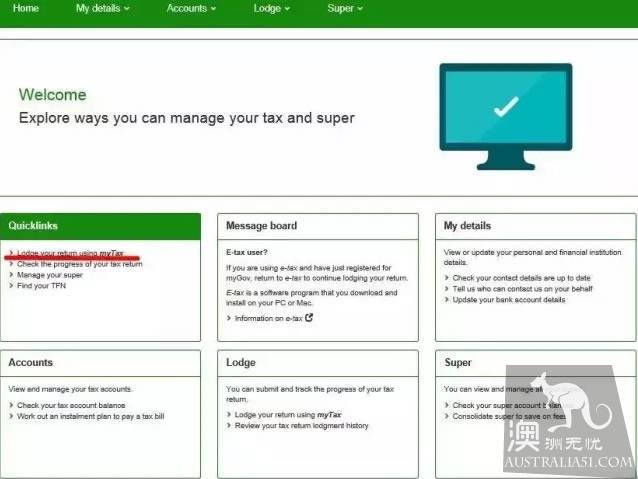
After the MyTax program is opened, the first thing to see is that you know if you meet the requirements for self-service tax rebate using this program. We must see if we have the appropriate qualifications, so as not to follow up unnecessary trouble!
Such as operating income or loss Business income or losses, has overseas income Foreign income, real estate rental income will lose Income or losses from rental properyies, and non-legal Australian taxpayer Not an Australia resident for tax purposes and so on are listed in the terms of the Not eligible.
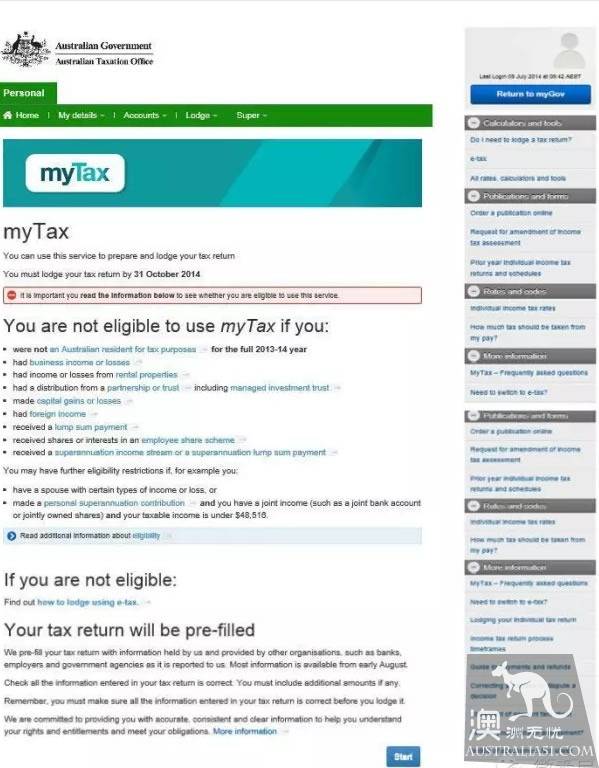
Of course, if the list of a few have nothing to do with their own, then congratulations everyone is qualified to use MyTax personal tax rebate, click on the lower right Start blue button, formally entered the tax rebate process!
The fourth step of the tax rebate process is divided into 9 steps, one step can not be less, step by step need to be cautious!
1, personal Information
After starting the tax rebate, the first step is Your Details. Fill in the correct personal information and contact information according to the form (must be able to find the contact details of the deceased!) And their own account information name, BSB, account number (if there is a tax refund, ATO will transfer the money to this account, so the family must not be wrong to fill out ah.)
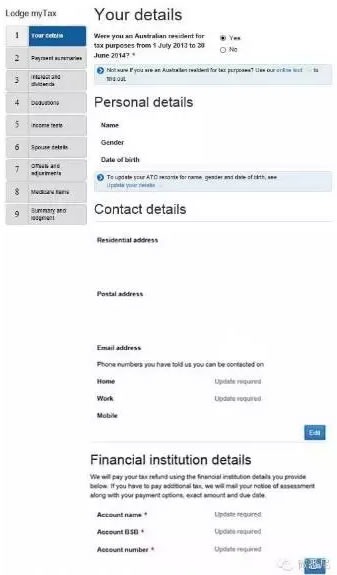
2. Summary of annual revenue
Once you have completed your personal information, it is your annual income. First, fill in your career and click on Add Payment Summary..
Then select the corresponding income categories according to their own situation, generally feel that everyone is the first-income and wages, but if individual families are receiving government benefits, then it is necessary to select the corresponding categories according to the categories of benefits received.
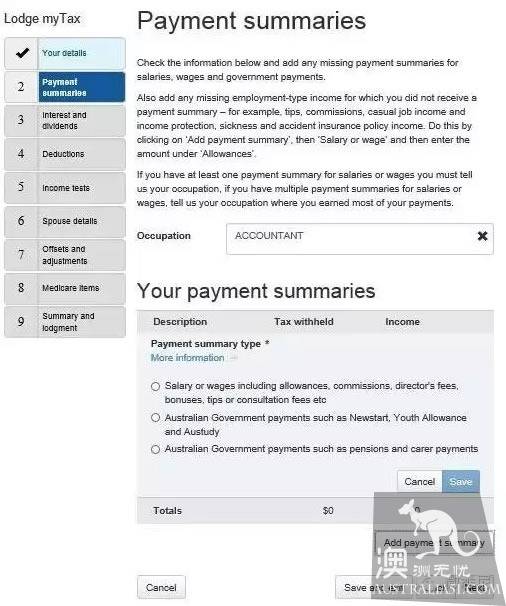
After the selection, there will be a number of information required to fill in the following, the editor will take the wage income categories required by the general public as an example, at this time we need the PAYG Payment Summary (annual salary summary / tax form prepared before). Fill in the web form according to the company information above.
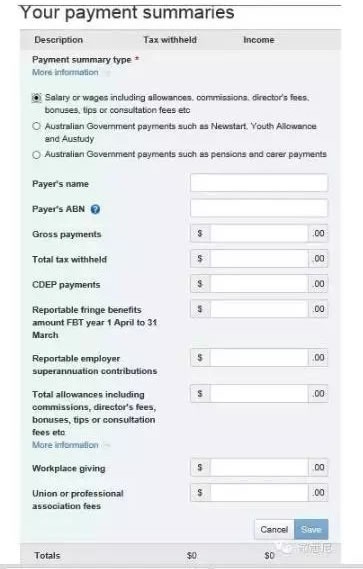
This also relates to the amount of the final tax refunded and underfunded, so remember to fill in the amount on the PAYG Payment Summary.
3, interest and dividends
When the company information is filled in, the interest and dividends will be filled in. In addition to the interest earned by the Bank of the year, Gross interest (will have to be filled in as long as the total interest in the financial year exceeds $1.) In addition, if there are other relevant interest and dividends (such as stocks, funds, investment dividends, etc.) are also required to fill in their specific amounts in the form, no need to fill in.

As for the specific types of the two, you can click on the blue More information on the page to learn more, because individuals vary depending on the situation, so I am not going to go over it here.
4, Deductions-magical income credits
To put it simply, Deductions is a credit for your tax income (pre-tax income), which is a legitimate and legitimate way to reduce the amount of tax you pay.
A total of 4 Deductions entries can be filled out in this interface:
A, bank interest income is credited to Interest Deductions-- if friends have bank interest income (generally everyone does), and banks charge account management fees for interest-generating accounts. That can be used as a credit in the case of a personal tax rebate.
If some partners have Cash Management Account, banks will also sometimes charge management fees, it can also be deducted as a tax rebate.
The total annual management fees would be better to consult the bank, or add up from the individual Statement.
B, bonus credit Dividend Deductions-- investment dividend credit similar to bank interest.
C, gifts and donations are credited to Gifts or Donations-- if you have contributed more than A $2 to ATO accredited charitable organizations or registered political parties in the fiscal year, then the donation can be considered a credit for individual tax rebates.
D, tax lawyer / accountant service charge credit to Cost of Managing Tax Affairs-- if you paid for the service in FY2015 / FY16 for hiring a tax lawyer or accountant, the credit can be made in FY 2016 / 17. It is important to note that the service charge delivered after July of that year can only be deducted in the next fiscal year when the individual tax rebate!

TIPS
1, fill in the credit content, friends should be reasonable according to the actual situation to fill in, otherwise it is easy to be audited by ATO!
2, all Deductions projects need to be based on the relevant basis, such as bank bills, checkout vouchers, small notes, etc., in case of ATO inspection, can not be imagined! (however, according to the information received from the editor, it is said that only when the credit amount is more than $300, ATO may ask for a small ticket as a basis. I believe there is no need for editor to say that everyone understands ~).
3, all the specific types of Deductions, if you do not know, you can click on the page under each item under the blue Moreinformation for detailed understanding, whichever!
5. Personal income assessment
This requires truthfully filling out the number of children in the family, because the number of children directly affects individual tax levels, so it is important for families to fill in the number of Dependent Children accurately and truthfully.
There is no child to write 0, must not be filled out! Fill in and click to move on to the next step.
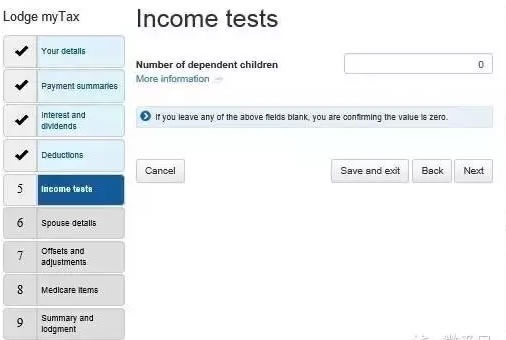
6, spouse information
Managers of existing spouses or de facto marital partners need to accurately fill in the other half of their personal information, annual income, additional benefits FringeBenefit, and pension Super amounts.

7, tax offsetting Offsets and debug Adjustments
Unlike Deductions, Offsets is a credit for its own taxes, which, in other words, is deducted directly from the tax paid until the tax is not paid.
In this interface, you can see that Offsets eligible groups include Senior and PensionerOffset, for the elderly and pensioners, as well as Zone or Overseas Force Offsets. for specific regional and overseas labour forces.
If you are aged in Australia, you can apply for this waiver and choose your own Tax offset code and Veteran code. correctly
For people working in remote areas or overseas, they can also apply for tax breaks depending on their own conditions.

In short, this entry is subject to personal circumstances. If you do not meet the above criteria, you do not need to fill in this page!
8, medical insurance
This applies to both Medicare and non-Medicare recipients, that is, if you do not have an Medicare, you can enjoy a full-year exemption from health insurance, and if you receive public health care throughout the year, you will not be able to enjoy the exemption.
2016 / 17 Financial Year is required to pay 2% of Medicare Levy for parents with pre-tax income of more than $21335, or vice versa. But, Medicare Levy will also vary according to the number of children, so in the previous Income Test list, we must write down the number of children!
Therefore, the people who can be exempted from medical insurance can be divided into three types, see the detailed introduction to the three categories that appear on the page, and relatives who meet the conditions can select Yes, without paying medical insurance tax.

Generally speaking, once you submit a PR application, you are eligible for the Medicare, and from then on you will have to pay the Medicare Levy. But before the moment you delivered PR, you didn't have to pay the money at all!
For example, Xiaoming submitted the PR, on January 1, 2016, after the end of the fiscal year, the annual income is 40, 000, if you do not apply for the MedicareLevy Exemption, will be charged by the Inland Revenue Bureau $800 MedicareLevy, but if you apply for MedicareLevy Exemption, then just half of it. Xiaoming did not need to pay the PR before it was submitted (July 1, 2015 to December 31, 2015). It was only after the submission of the PR (January 1, 2016 to June 30, 2016) that Medicare Levy. was levied by the Inland Revenue Bureau.
So, here's the problem-
How do you avoid being charged by ATO for personal tax rebates in the fiscal year?
The specific steps are as follows:
First, friends need to apply for the Medicare entitlement statement, application form and download it here: https://www.humanservices.gov.au/customer/forms/ms015 and, in addition to filling out the application form above, Materials are also required (both the list of materials and the form of application are written on the last page of the application form).
Then, the material will be scanned as above, e-mail to [email protected] for application. (of course, you can also apply by mail or fax in the lower-right corner of page 1 of the application form.)
Finally, in about a month and a half, your mailbox (not Email) will receive a copy of the paper Medicare entitlement statement that clearly states your not being eligible for Medicare benefits,. That means you're not eligible for Medicare (meaning you don't have to pay Medicare's money, don't look at Not Eligible and mistakenly assume that the application failed!).
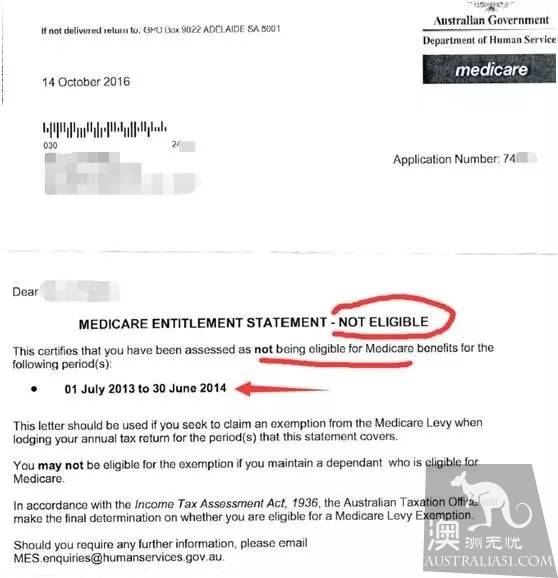
With this sheet of paper, families will be able to tick MedicareLevy Exemption and enter exemptions for 365 days when they file their taxes.
Note that if you submit a PR, you can only apply for Medicare Levy Exemption (for the period prior to the submission of the PR. Please refer to the previous Xiaoming example.
So, if I had been charged by the Inland Revenue Department, could I have it back? The answer is yes! But it can only be returned within the last 2 years (this 2 year refers to the two years of date of issue on Notice of Assessment)!
First, it's important to get the Medicare Entitlement Statement (as above!) Second, log in to your own MyGov account and you will see the Amend button there in your tax rebate record, as shown below:
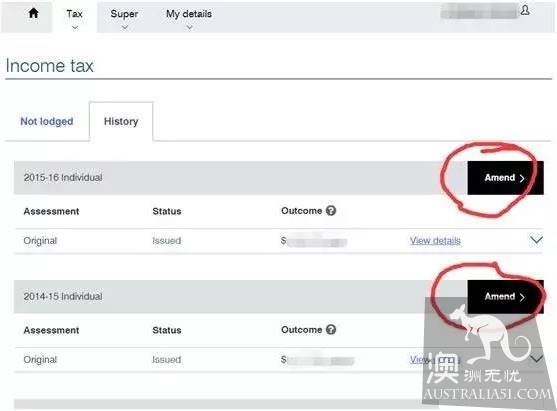
Click on the Amend button to change the Medicare piece of information to the correct (do not need to upload that Medicare entitlement statement, if you need to provide it, ATO will contact you ~ then, families just sit and wait for ATO to return the money to you ~ so easyy!
High-income people who earn more than $90000 a year before tax and who do not have a private health insurance Personal Health Insurance are required to pay an additional health insurance tax, Medicare Levy Surchange.
So, the MLS depends on whether the taxpayer himself has private health insurance and different family circumstances, that is to say, when filling out the form, it is necessary to write down whether they and their families have Private patient hospital cover.. Must be to cover the hospital Hospital Cover can Oh!
In addition, be sure to write down your own private health insurance Private Health Insurance information as required at the end of the day. Complete it all and click to go to the last step.
9, estimate the amount of tax rebate, complete the "personal tax refund trip"
After entering the final step, the system will estimate the amount of tax refund based on all the information and amounts you have previously filled in. After careful confirmation of the figures, check the Declaration Box..
If ATO volunteers Tax Help Volunteer help to complete the tax rebate process, then the ID number should be filled in the last space, if not, do not need to fill in.

After all checks are complete, click the blue Submit button at the bottom of the page to complete the entire self-service tax rebate process. Now you can wait quietly for the tax to enter the bag! And it's not as complicated as it was supposed to be.
Some of TIPS's instructions on reporting related work expenses during the tax rebate process are as follows:
- The reported expenditure must be expenditure for the financial year;
- All reporting credits must be work-related and must not be a private expense. If the individual has previously reimbursed the employer for this expense, he or she may not report it again in the tax rebate.
- If the amount of the program is more than A $300, it will need to be maintained to provide a record of related consumer expenditure as a voucher. Of course, in order to avoid the loss of paper vouchers, ATO website has a list of "acceptable records" for you to refer to when the tax rebate.

